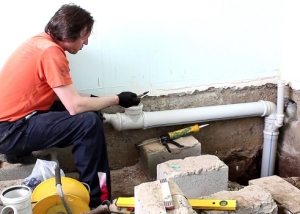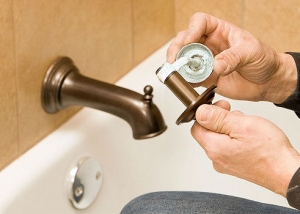Crimp flange - a connecting structure used in the installation and repair of pipelines and the connection of various flange fittings. The use of a crimp flange avoids welding. The universality of an exceptionally reliable fitting is expressed in the possibility of connecting pipes from different materials - cast iron and steel, asbestos cement and polymers.
Content
Design and use of crimp flange for cast iron pipes
The design of the cast iron flange consists of:
- enclosures with fittings made of ductile iron coated with epoxy;
- flat metal rings;
- sealing gum to compensate for linear expansion;
- fasteners.
To install the crimp flange, resort if necessary:
- quick and reliable connection when starting the plumbing / sewer system without prior testing;
- docking of products from different materials, for example, cast-iron pipes and PVC, and with different diameters;
- removal of the voltage arising in the pipes. Elastic connection to a large extent prevents the occurrence of an emergency;
- future joint dismantling or system configuration changes;
- multiple installation;
- achieving lack of leaks;
- installation of an additional locking element;
- due to inclement weather.
Crimp flanges are designed for operation in water supply and sewage systems, transportation of slightly aggressive environments and viscous liquids. The value of the working pressure in the systems can reach up to sixteen atmospheres, the temperature - from -25º C to + 70º C.
The advantages of universal crimp flanges are seen in:
- ease of installation and dismantling, which does not require the involvement of specialists and the use of special equipment. No need for welding, and lip seal allows you to apply little effort;
- a lifetime of more than a decade;
- protection against corrosion;
- the ability to connect almost all types of pipes due to the large compressible range.
Crimp flange mounting
The use of crimp fittings simplifies repair work. The tightness of the compounds does not suffer at all, while they gain elasticity, which helps to reduce accident rate.
The crimp flange is mounted in the following order:
- The pipe is cut at a right angle. Note that the design of the fitting allows you to successfully use it with an uneven cut. The chamfer after trimming is not removed.
- The flange is put on the end of the pipe with the side where the diameter is smaller.
- The installation of the o-ring protruding beyond the edge of the pipe at a distance equal to one centimeter.
- The rubber seal is covered with a layer of grease.
- The fitting is pushed all the way onto the rubber seal.
- The bolts are tightened with a wrench using a cross order.
The installation of the crimp flange, regulated by GOST 12815-80, can significantly reduce their time and cost, avoiding damage to materials that is inevitable when using welding equipment.
When joining pipes with flangeless ends or connecting a fitting to a stop valve or other device, they resort to installing flange adapters. The design includes:
- coupling;
- flange and pipe welded to it.
The use of a flange adapter is associated with:
- ease of installation;
- possibility of application in land and underground conditions;
- free access for maintenance;
- resistance to high temperatures and corrosion;
- duration of operation.
Use of crimp flange for joining PVC and PE pipes
The spread of polymer engineering communications led to the appearance of crimp flanges adapted for installation in non-traditional conditions for them. Such flange adapters are not suitable for use on cast iron pipes, as they are adapted for operation in a completely different environment. For production, fusible cast iron is used, galvanized mild steel is used for support sleeves, and stainless steel is used for fasteners. In products with a diameter of up to 125 mm, only two bolts are provided, which are easily tightened with an ordinary wrench.
The design is ready for installation without prior adjustment. Clamping control allows repairs even in flooded spaces, easily connecting both spiral and oval pipes. Tightness when changing working pressure is provided by a three-point sealing system.
Using crimp fittings for PVC and PE pipes allows you to:
- connect products with a diameter of 63-315 mm;
- quickly carry out installation almost regardless of working conditions;
- establish a fixation that blocks the constriction of the pipe;
- eliminate the need for a support sleeve;
- to achieve increased tightness with increasing working pressure;
- get an environmentally friendly anti-corrosion coating that does not impair the quality of drinking water;
- to connect products from different materials.
The use of crimp flanges allows you to quickly carry out installation and repair of the pipeline, significantly saving on the cost of work. The quality of the joints and the durability of their operation are guaranteed, regardless of the material and diameter of the products.









